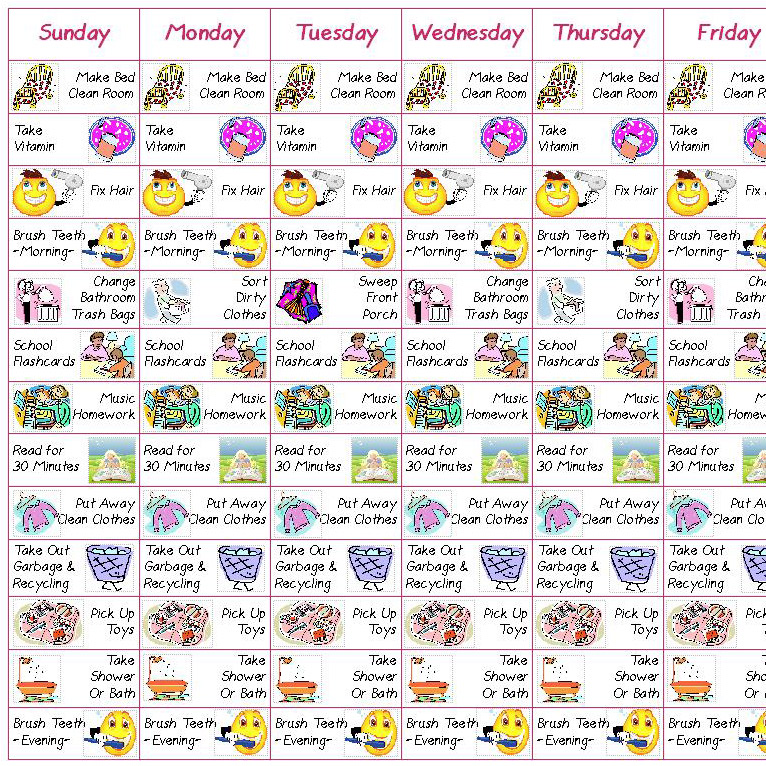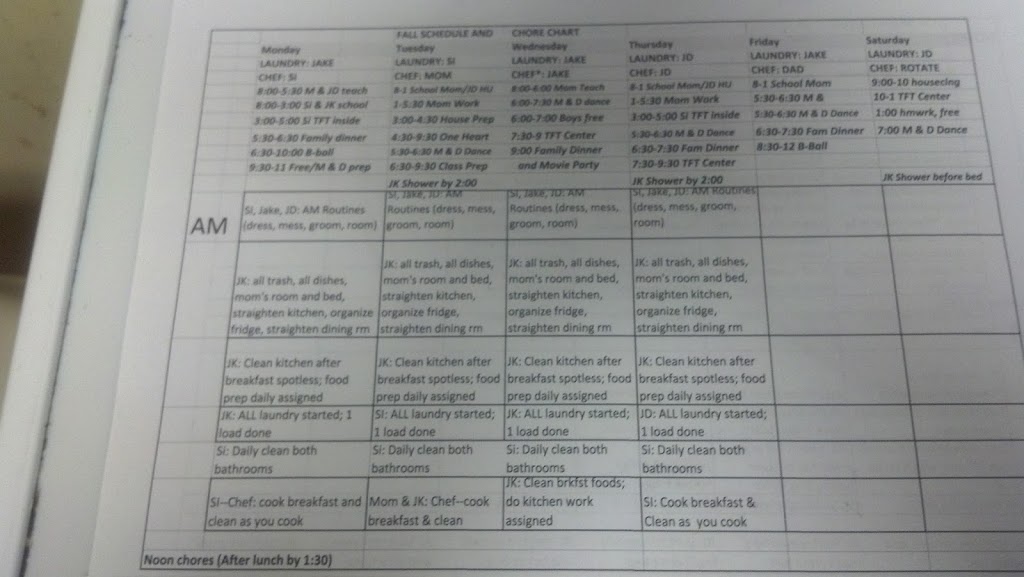
by Donna | Sep 12, 2013
 |
| image helpformothers
|
Today I would like to leave you some tips for Independent Work Lists–especially for older students (junior high through high school). These will be in no true order–just some things that I want to re-emphasize from the younger ages as well as things that pertain only to olders.
So here we go:
1. Consider the document or chart that works best for your age child now. Most kids in junior high and high school no longer want cutsie charts. Once you decide you want a genuine paper document, then you have to decide how you want it filled in:
a. As he goes, he lists what he does each day, sort of a daily school journal.
b. You write in a planner each week for him for the following week (page number, number of pages, lesso number, etc.).
c. You have a standard daily Independent Work List that you create in your scheduling program or Excel—that you can customize when something changes, etc. You print this off, put it on a clip board, and have him highlight or mark off as he does things each day.
2. Consider if you are going to make his Independent Work List for him completely or if you will have his input. We liked to choose our high schoolers materials, schedules, lists, etc., with them, so that they have some input in the process–and to help model for them/teach them how to organize, prioritize, etc.
3. Still use some of the elements from the earlier suggestions (for younger kids) that are universal, such as:
a. School is your child’s occupation. It is what he should be about during the day.
b. Put the daily tasks in sections according to time of day or importance–and also in order according to when they should be done.
c. Do your part to be sure that charts are updated, printed, and ready. I know from personal experience that if we are laxed in this–they become laxed real quick!
d. Have a system that works for you every day. Have his list on a clip board that he carries with him/keeps in his school area. Have him highlight as he does things. Have him leave it on your desk when he is done, etc.
e. Develop a “no exceptions” approach to daily independent work. A student doesn’t go to basketball, girls group, youth group, etc., until his daily independent work list is done.
4. Have blanks on the chart to add in any work from outside classes, music lessons, Bible quizzing, etc.
5. Put things that are not dailies where ever they go. This was always a little bit difficult for me. Do twice weeklies go on Tuesday and Thursday (but Thursday is our lesson and errand day…). Do three times weeklies always go M-W-F, even though Wednesday is our “cottage class day” and extras do not get done on that day. This might take a while to get in the groove, but it is worth it to tweak things and make it work.
6. For junior high kids, consider that you might need smaller chunks (maybe two math sessions at 30 minutes a day, etc.). Again, you know your student and your family situation, so do whatever works best for you.
7. Consider if you want this Independent Work List to be his total chart/list for all aspects of his day at older ages:
a. Do you want to put his devotions, music practice, and outside work on there too?
b. Do you want it to contain meetings/tutoring sessions with you?
c. Do you want it to also be his chore list?
There are some definite advantages to a junior high or high schooler having his day right in front of him in one spread sheet. However, this can also get overwhelming to some kids.
Feel free to ask questions here on FB about the Independent Work Lists–I will try to answer them. I can’t imagine not having homeschooled without our three daily task lists: (1) Morning routines; (2) Chore charts; (3) Independent Work Lists!

by Donna | Sep 12, 2013
 |
| image clker.com |
Once school starts and the textbooks have been previewed, you can help your students get into good homework habits by doing their homework with them for a few weeks.
Here are some tips along those lines:
1. Taking the textbook preview further
There are a number of ways that you can take the previewing of textbooks that I discussed yesterday even further with your children for more comprehension of the material:
a. Do his first few assignments out of the book with him, pointing out the things again that you observed in your first preview. This will help him see that those things are not just good things to know, but also helpful for completely homework quicker and more accurately.
b. Help him prepare for his first test with his textbook and you by his side. Show him how he can use the glossary, sidebars, table of contents, etc. to quickly fill in his study guide or quickly determine what the most important aspects of the chapter are in order to prepare for a test.
c. As you are previewing a text (for the first time or an additional time), use a large sticky note to record what you find. Write the title of the text at the top, then make notes about what it contains as far as study and homework helps. Stick this in the front of his textbook and help him refer to it when he is doing homework or test preparation. You could even record a plus and minus system, such as
+++ means something is going to be really helpful—a +++ beside the Table of Contents, for instance
+ beside a word he writes in the front of his book tells him that this might be somewhat helpful—Example: +Some graphs
– No study questions at end of chapter—again, he can make a list in the front of his book (on a large sticky note), etc.
d. Help him “label” different sections of his book with sticky notes along the edges. For example, you could put a yellow one at the beginning of each chapter and a pink one on the page that has definitions for that chapter, etc.
2. Prepare your younger student for textbooks by using user-friendly non-fiction books
Maybe you are not in the textbook stage with your kids; however, you can begin preparing them for those all important study skills that I described yesterday with quality non-fiction books. If kids at ages five, six, eight, and ten, learn to navigate around Dorling Kindersley, Eyewitness, and Usborne books (among many others), they will be heads and shoulders above other children who have only been exposed to fictional stories (more on the benefits of fiction later!).
These outstanding non-fiction books have literally hundreds of topics that interest kids, but they are so colorful and alluring, you do not feel like you are “teaching” at all. Additionally, they have many aspects that your child’s future textbooks will also have: glossaries, Tables of Contents, sidebars, graphs, pictures, inserts, definitions, bold font, italics, etc. Reading these to and with your children when they are younger will provide a natural step into textbooks later on.
Note: We teach our students (in our home, our cottage classes, and in our language arts books) a simple memory device for remembering fiction and non-fiction:
Fiction=fake (both begin with f)
Non-fiction=not fake (both begin with nf)

by Donna | Sep 11, 2013
I is for INDEPENDENT WORK!
 |
| Chart by picstopin.com |
If you don’t start Independent Work Charts/Lists with your littles, you will definitely want to start it in elementary school after your child learns to read!
(Some people feel that they have very little to put in an Independent Work Chart for little kids. We always managed to find things as I felt it kept my littles learning and exploring all the time–and it helped my preschoolers to NEVER be bored!)i
Here are some tips for creating Independent Work Lists for elementary children:
1. Either make it on a chart that the child uses wipe and write markers and mount it somewhere–or make it in Excel (or your favorite record keeping program) and place it on a thin clip boards.
Trust me: loose papers never make it back to mom at the end of the day. (Spoken from true experiences–plural–you would think I would have learned this the first time or two! 😉 )
2. Put things in the order of importance on the chart–in the order that you want them done.
3. And/or put things in sections.
I used to have mine in order and sections–the first so many items needed done before the child met with Mom or before the child had a morning snack or before lunch chores, or whatever. Never underestimate the value of teaching children time management, prioritizing, etc. via these daily checklists.
4. Explain to your child that this is his daily accountability list.
He is to get these things done each day. (Hint: We taught our children from their earliest recollection of school that school is their occupation. It was what they were supposed to be about every day. No questions asked. No exceptions (unless we parents wanted an exception for sickness or family trips, etc.–in other words, the child doesn’t choose to do school or not do school–ever).
5. For things that you are uncertain of/change-ables, put time or generic wording, such as “30 minutes of uninterrupted CQLA work” or “All CQLA assignments from previous meeting with Mom,” etc.
6. Be sure to include drill work, silent reading, etc.–all the extras that you want him to do each day.
(I even put the things that they would often do as I read aloud on this list in the section marked “During Read-Aloud”–such as coloring in educational coloring book, penmanship page, building something with Legos, etc.)
7. Be sure there is a time in which it is turned in each day.
This is kind of another subject, but it fits here as well: A child should not go to basketball practice, Girl Scouts, youth group, or any other activity if he doesn’t do his school. Period. We have so many parents come up to us at conventions and say, “I just can’t get my fifteen year old to finish his school each day, and he keeps getting further and further behind.” Then we ask, “Does he go to sports practice in the afternoon? Does he go to youth group that night?’ etc. etc. None of those things should ever happen if he doesn’t do his school. School is non-optional.
If your child’s independent list is on a clip board, he can simply put the clip board on your desk at the end of the day–all checked off and ready for the next day.
8. The Independent Work Checklist is, in part, to help keep the child moving as you are working with other kids, walking your college kids through a difficulty on the phone, or helping Grandma with something. In other words, you want to teach your student to get up and start on the list right away–and to go back to the list any time he is not meeting with you or doing chores, etc. (I even put things like “Read to Jonathan for 15 minutes” and “30 minutes of morning devotional book and journaling” on the list–everything the child does (outside of chores) was listed on this chart.
I just can’t stress enough the benefits of the Independent Work Lists–for Mom and for the student. It takes away gray areas of parenting (something crucial that we teach in our parenting seminars). It helps the child become an independent learner. It teaches many character qualities–perseverance, prioritizing, resourcefulness, responsibility, diligence, timeliness, and much more. Yeah, I am pretty crazy about my thirty years of Independent Work Lists! 😉

by Donna | Sep 10, 2013
 |
| Speaking about “Building Study Skills and Comprehension” at a conference |
There are many aspects of teaching a child how to learn, one of which is working to increase our children’s comprehension. When people have good comprehension, they can learn anything, anywhere, anytime.
There are three primary ways that we have worked to increase our children’s comprehension: (1) Discussion with parents and those more knowledgeable than the child; (2) Good questions following reading or discussions; and (3) Provide a rich background of experience.
The first two of those go hand-in-hand. Discussion of everything with our children from very young ages has given our kids experiences in areas that they would normally not have experiences in. It gives us the opportunity to teach all the time—and gives them learning hooks that they create with the discussion material to bring into other learning situations.
Good questions, not just rote questions, help the student think more deeply about subjects and allow you to observe his thought processes and help them along. Lastly, a rich background of experience gives your student the edge in learning any subject. Like discussion, it gives a child more knowledge, more background, more information to bring into future learning scenarios.
I am adding some information about teaching children how to learn, good materials, links to articles, etc., in the sidebar of this article for those who would like to study this further. Just being aware of always teaching our kids how to learn, how to study, how to research, how to further their understanding is a big step in teaching kids how to learn.
SIDEBAR….
Tips and Links for Teaching Children How to Learn
~People often ask us what we would have done differently in our homeschool. One of the things I would have done differently is that every child, every year would have done a thinking skills book of some sort from the Critical Thinking Company: https://www.criticalthinking.com/index.jsp?code=c

by Donna | Sep 7, 2013
 |
| When our children got older, I moved out of colorful chore charts on poster board types of display and into typed charts created in Excel in report covers. |
When it comes to chores, I am thankful that I learned the approach that we have used for the past twenty years plenty early in my homeschooling tenure:
1. Attach three different chore sessions to twenty to thirty minutes prior to each meal.
2. Use one of your “chorers” for meal preparations for that upcoming meal. (Eventually, our kids did breakfasts and lunches completely by themselves for the family–and either did dinner with me or rotated through and took a different night each week as they got older.)
3. Put the most crucial chores in the first chore session–the things that need done every day regardless. For us, this meant one load of laundry, one load of dishes, trash throughout the house, wipe down bathrooms, get out/start something for evening meal, and fix breakfast. This way you will almost always get to the priorities (“dailies”)
4. In the second chore session, put more dailies and a couple of weekly tasks. (For us, this meant another load of dishes, laundry, and trash; lunch preps; possibly baking; and another weekly or two, such as dusting and vacuuming, cleaning out fridge, etc.)
5. In the third chore session, I put the things I only dream of getting to and dinner preps. (I always had a child in the kitchen with me each evening as I prepared dinner–unless the child fixed it himself or herself!)
6. Before each chore session, I called out “Room to Room”–which meant that each person should go through the main rooms and pick up what they have out. This allowed the chorer for that room to dust, vacuum, etc., without having to pick up first.
The key to successful chores, in my opinion, include the following:
A. Do dailies daily! Do not skip dailies. Do not try to do anything else until the dailies are down pat.
B. Never miss the first two chore sessions!
C. Have everybody work the entire chore session. (If someone got done early, he came to get another task or helped someone else. This wasn’t a race–it was a daily lifestyle that helped us have time for homeschooling and all of the wonderful teaching, heart training, and family times that we wanted to have.)
D. Don’t make it the least bit optional. After a couple of months of this lifestyle, my kids never even questioned whether they had to fold and put away three loads of laundry that day or fix lunch every day or cut up a fridge full of veggies. It was a way of life–a way of life that made our family successful.
E. Don’t eat until the work is done!
F. Have I mentioned not to skip?

by Donna | Sep 2, 2013












